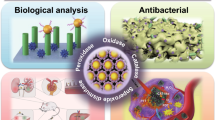Abstract
Biocompatible magnetic nanoparticles have been found promising in several biomedical applications for tagging, imaging, sensing and separation in recent years. Most magnetic particles or beads currently used in biomedical applications are based on ferromagnetic iron oxides with very low specific magnetic moments of about 20–30 emu/g. Here we report a new approach to synthesize monodispersed core-shell nanostructured clusters with high specific magnetic moments above 200 emu/g. Iron nanoclusters with monodispersive size of diameters from 2 nm to 100 nm are produced by our newly developed nanocluster source and go to a deposition chamber, where a chemical reaction starts, and the nanoclusters are coated with iron oxides. HRTEM Images show the coatings are very uniform and stable. The core-shell nanoclusters are superparamagnetic at room temperature for sizes less than 15 nm, and then become ferromagnetic when the cluster size increases. The specific magnetic moment of core-shell nanoclusters is size dependent, and increases rapidly from about 80 emu/g at the cluster size of around 3 nm to over 200 emu/g up to the size of 100 nm. The use of high magnetic moment nanoclusters for biomedical applications could dramatically enhance the contrast for MRI, reduce the concentration of magnetic particle needs for cell separation, or make drug delivery possible with much lower magnetic field gradients
Similar content being viewed by others
References
Andra W. and Nowak H. (1998). “Magnetism in Medicine”. Wiley-VCH, Berlin
Brigger I., C. Dubernet & P. Couvreur, 2002. Nanoparticles in cancer therapy and diagnosis. Adv. Drug Delivery Rev. 54631–54651
Whitesides G. & A.P. Alivisatos, 1999. Fundamental scientific issues for nanotechnology Nanotechnology Research Directions. A.P. Alivisatos et al. ed. IWGN Workshop Report
Cancer Nanotechnology Plan, A strategic Initiative to Transform Clinical Oncology and Basic Research through the Directed Application of Nanotechnology, U.S. Department of Health and Human Services, National Institutes of Health, National Cancer Institute, July 2004
Fritzsche W. and Taton T.A. (2003). Metal nanoparticles as labels for heterogeneous, chip-based DNA detection. Nanotechnol. 14: R63-R73
Hadjipanayis G.C., Siegel R.W. (eds). (1994). Nanophase Materials. Kluwer, Dordrecht
Haefeli U., Schuett W., Teller J., Zborowski M. (eds). (1997). Scientific and Clinical Applications of Magnetic Carriers. Plenum Press, New York
Hatch G.P. and Stelter R.E. (2001). “Magnetic design considerations for devices and particles used for biological high-gradient magnetic separation systems”. J. Magn. Magn. Mater. 225: 262–276
Jordan A, Scholz R, Maier-Hauff K, Johannsen M, Wust P, Nadobny J, Schirra H, Schmidt H, Deger S, Loening S, Lanksch W and Felix R (2001). J. Magn. Magn. Mater. 225: 118
Kim Do K., Mikhaylova M., Zhang Y. and Muhammed M. (2003). “Protective coating of superparamagnetic iron oxide nanoparticles”. Chem. Mater. 15: 1617–1627
Matijevic E. ed. 1989. Fine Particles A special issue in MRS Bulletin 14, 18; Matijevic E. 1993. Chem. Mater. 5, 412
Meldrim J.M., Qiang Y., Sellmyer D.J., Haberland H. (2000). "Magnetic properties of cluster-beam synthesized Co-noble metal films". J. Appl. Phys. 87: 9–7013
Portet D, Denizot B, Rump E, Lejeune J.J and Jallet P. (2001). J. Colloid Interface Sci. 238: 37
Qiang Y., Thurner Y., Reiners Th., Rattunde O. and Haberland H. (1998). "TiN and TiAlN coatings deposited at room temperature by Energetic Cluster Impact (ECI)". Surface and Coatings Technology 101/1–3: 27–32
Qiang Y.R. Morel, E. Eastham, J.M. Meldrim, J. Kraft, A. Fert, H. Haberland & D.J. Sellmyer, 2000. Magnetic properties of cobalt clusters embedded in a nonmagnetic matrix (Ag, Cu, SiO2), Cluster and Nanostructure Interfaces, Jena, P., Khanna, S.N. and Rao, B.K. eds. Would Scientific
Qiang Y.R.F. Sabiryanov, S.S. Jaswal, Y. Liu, H. Haberland & D.J. Sellmyer, 2002. Magnetism of Co nanocluster films, Phys. Rev. B 66, 064404
Qiang Y.J. Antony, M.G. Marino & S. Pendyala, 2004. Synthesis of core-shell nanoclusters with high magnetic moment for biomedical applications. IEEE Trans. Magnet. November 2004, 3538–3540
Reich D.H., et. al., (2003). “Biological applications of multifunctional magnetic nanowires”. J. Appl. Phys. 93: 7275–7280
Sellmyer D.J., Lou C.P., Qiang Y. and Liu J.P. (2002). “Magnetism of Nanophase composite films”. In: Nalwa H.S. (eds). Handbook of Thin Film Materials. vol. 5, Academic Press, New York
Sugimoto T. (2000). Fine Particles: Synthesis, Characterization and Mechanism of Growth. Marcel Dekker, New York
Tada M.S., Hatanaka H., Sanbonsugi N., Matsushita and Abe M. (2003). “Method for synthesizing ferrite nanoparticles ∼ ∼30 nm in diameter on neutral pH condition for biomedical applications”. J. Appl. Phys. 93: 7566–7568
Xu Y., Sun Z., Qiang Y., and Sellmyer D. (2003). "Magnetic Properties of L10-FePt and FePt:Ag Nanocluster Films". J. Appl. Phys., 93: 10–8289
Zhao M., Kircher M.F., Josephson L., and Weissleder R. (2002). Differential conjugation of Tat peptide to superparamagnetic nanoparticles and its effect on cellular uptake. Bioconjug. Chem. 13: 840–844
Acknowledgements
Financial support from the NSF-EPSCoR, NIH-INBRE and the University Research Office of the University of Idaho for the purchase of a SQUID instrument (MPMS XL-7, Quantum Design, Ins) is gratefully acknowledged. TEM data was collected at EMSL, a user facility sponsored by the DOE and operated by Battelle. Dr. Chongmin Wang at PNNL is thanked for highly valuable TEM assistance.
Author information
Authors and Affiliations
Corresponding author
Rights and permissions
About this article
Cite this article
Qiang, Y., Antony, J., Sharma, A. et al. Iron/iron oxide core-shell nanoclusters for biomedical applications. J Nanopart Res 8, 489–496 (2006). https://doi.org/10.1007/s11051-005-9011-3
Received:
Accepted:
Published:
Issue Date:
DOI: https://doi.org/10.1007/s11051-005-9011-3




